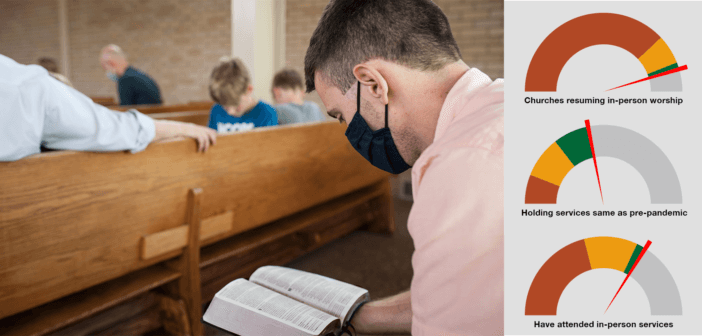Amy Kubichek of the Lewis Center staff shares Pew Research Center findings on how COVID-19 has impacted religious participation. As of March 2022, 90% of congregations had resumed in-person worship services, but only two-thirds of those who typically worship at least once a month have attended in person. Twenty-one percent are worshiping only online or on TV, and half of those who have attended in person are also worshiping digitally.
How are congregations faring two years after the outbreak of the COVID pandemic in the United States? Has the number of worshipers who attend services in their houses of worship reached the level it was before the pandemic started? Is worshiping online still the “new normal”?
Starting in July 2020, Pew Research Center carried out a series of surveys of U.S. adults who attend religious services to assess how COVID-19 has impacted worshipers’ modes of religious participation. Here is what we can glean from these surveys, the most recent of which was conducted in March 2022:
1. Ninety percent of congregations have resumed in-person worship.
The share of congregations that hold in-person worship services increased substantially between the spring and fall of 2021 but plateaued between fall of 2021 and spring of 2022. The percentage of congregations that opened their doors to hold services in person increased from 76% in March 2021 to 88% in September 2021. During the six-month period between September 2021 and March 2022, the share of congregations holding in-person services increased by only 3 percentage points to reach 90%.
2. Forty-three percent of religious participants said their congregations are holding services the same way they did before the pandemic.
Compared to surveys six months and a year earlier, more religious participants surveyed in March 2022 reported that their houses of worship have returned to operating the same way they normally did before the start of the COVID-19 pandemic. Forty-three percent of U.S. adults who said they participate in religious services (regularly or otherwise) said their congregations now hold religious services in the same way as before the beginning of the pandemic, up from 29% six months earlier and only 12% in March 2021. The share of individuals who said their congregations have in-person services with modifications for COVID declined steadily from 64% in March 2021 to 47% in March 2022.
Congregations belonging to different religious traditions have responded to the outbreak and waning of the COVID-19 pandemic in different ways. In March 2022, 60% of evangelical Protestants who reported that they were regular attenders stated that their congregations were currently holding services in person with no modifications for COVID, while less than half of Catholics (43%) and a third of mainline Protestants said this was true of their congregations. Only about one-fifth (21%) of those who regularly attend historically Black Protestant congregations stated that their churches were operating the same as they had before the start of the pandemic.
3. Sixty-seven percent of typical worship attenders have attended in-person services.
Among those who said they typically attend worship services once a month, the share who attended a worship service in person in the last month also increased substantially during the six-month period between the spring and fall of 2021, but it remained almost the same between the fall of 2021 and spring of 2022. Forty-two percent said they attended an in-person service in March of 2021, but this increased to almost two-thirds (64%) by September 2021. Six months later, the share of worshipers who attended an in-person service increased by only three percentage points to reach 67%.
It is interesting to note that the share of worship attenders who attended an in-person service in the last month is much lower than the share of congregations that have opened their doors to in-person worship services. For instance, while three-quarters of congregations held services in person in March 2021, fewer than half of worshipers reported that they attended a service in person. And a year later, 90% of congregations held in-person worship services, but only two-thirds of worshipers attended a service in person.
4. Over half of those who attended services in person also watched services online or on TV in March 2022.
An almost equal share of regular attenders reported that they had only attended services in person (31%) as those who stated that they attended services both in person and online (36%). About one-fifth (21%) said they only watched services on TV or online.
The share of regular attenders who attended services in person, online, or both in person and online in March 2022 varied by religious tradition. Among Catholics, the largest share (45%) only attended services in person while the largest share of Protestants (43%) attended services both in person and watched services on TV or online. Among those who regularly attend historically Black Protestant congregations, an almost equal share only watched services on TV or online (35%) as those who both attended in person and watched on TV or online (38%). About three in ten evangelical Protestant worshipers (29%) and mainline Protestant worshipers (30%) attended services both in person and watched services online or on TV. While the share of mainline Protestants who attended a service in person in the past month increased substantially between September 2021 and March 2022, rising from 56% in September 2021 to 68% in March 2022, the share of historically Black Protestants and evangelical Protestants who attended a service in person remained almost the same during this six-month period.
It is still difficult to know how much the pandemic has really altered how people worship for the long haul — either by watching services online or TV or attending services in person. This is because, in their surveys of religiosity and worship attendance in the United States prior to the pandemic, Pew Research Center did not ask respondents to distinguish between whether they physically attended their congregations’ services or whether they watched services on TV or online.
This article is based on a Pew Research Center report by Justin Nortey, published March 22, 2022: “More houses of worship are returning to normal operations, but in-person attendance is unchanged since fall.”
Related Resources
- “Positioning Your Church for Growth in a New Season of Ministry,” a Leading Ideas Talks podcast episode featuring Tony Morgan
- Moving Forward with Hybrid Worship by Olu Brown
- What to Watch in 2022 by Doug Powe and Ann Michel





